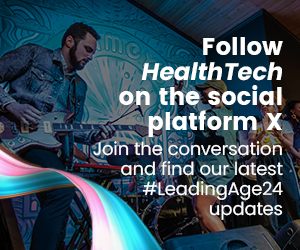Data Improves Resident Engagement In Senior Living Organizations
“Health and wellness empower value-based care,” said Kunaal Goel, vice president of analytics and insights at Sentrics during a session on unlocking the power of data in senior living.
He emphasized that using data analytics can give senior living organizations insights into their residents’ social determinants of health and allow the community to evolve beyond using only clinical interventions to help residents. In senior living, SDOH data refers not only to measures such as economic stability, education and access to healthcare, but also to intellectual and social stimulation and access to food.
Healthcare’s focus more generally is shifting from acute-care interventions to whole health. If senior living organizations do not follow suit, they could be left behind. Another driver for a value-based care approach to senior living is that residents expect to live in environments that support physical, mental and emotional well-being.
Finally, payer and senior living goals come together in value-based care according to Goel. Payers want to achieve better outcomes that drive long-term cost savings by prioritizing whole health and comprehensive care coordination. Organizations can improve outcomes through preventive care and analytics. There are financial incentives to do so as well. Value-based care structures provide organizations with increased bonuses for meeting those goals. At the same time, there could be a reduction in bonuses for organizations unable to provide the same level of care that an operator expects.
DISCOVER: These tips can help senior care organizations navigate innovation and AI.
Goel said that senior living and home health organizations need to understand how to provide accessible care and appropriate interventions where they are. That means it’s important for care teams and senior living staff to know how residents are acting at home.
According to Goel, attending events has an impact on getting residents to stay with a community. Loneliness can cause cognitive decline, whereas leisure activities that provide mental, physical and social stimulation can reduce loneliness. While all residents will have days when they are unsociable, organizations can use data analytics to determine a resident’s baseline and pinpoint when they start to exhibit abnormal behavior requiring interventions to prevent them from having a bad health outcome or leaving the community.
“You can use engagement analytics to see if residents are pursuing events that give them purpose,” said Goel. Those analytics can come from advanced location services that measure time spent in their room, alarm disposition, an increase in social requests or physical movement using an accelerometer. All of this information ladders together to ensure the organization has the data necessary to make nonclinical interventions that can increase the length of stay and decrease the need for acute-care interventions.
However, Goel emphasized the need to look at trends in data more closely to get to the bottom of an issue. An increase in average alarm response time could drive leadership to allocate more resources to an overnight shift when it may be that a care staff member has been desensitized due to alarm fatigue caused by repeated alarms from one resident. In this case, the solution might be additional training and a meeting with the resident and their family.
Goel recommended creating a data culture now. The organization can start by maximizing existing tools using data and a focus on short-term changes. Doing this can demonstrate that the organization is taking the right steps to care for residents.
DIVE DEEPER: Accelerate innovation in senior living and post-acute care.
Tips on How to Become a Data-Driven Aging-Services Organization
Being able to make use of the rapidly growing store of data owned by senior living and post-acute care organizations through Internet of Medical Things devices, electronic health records, resident engagement platforms and other technologies is crucial to maintaining a competitive advantage, reducing expenses, retaining employees and improving resident satisfaction and patient outcomes. It’s important for aging-services organizations to understand what data they already have, tools available to manage and report on that data, as well as how to get that data to all levels of the organization.
“Too often this is seen as an IT project, but it’s far from it. Data analytics is a business tool,” said Terry Freed, president and CEO of Prelude Services.
Freed explained that while everyone wants to use data effectively, he estimates that fewer than half of aging-services organizations are aggressively working toward a robust data strategy.
“The process of trying to get your arms around data is intensive. When trying to fight day-to-day operations problems, data might not be at the top of your list,” said Freed, who added that many organizations are just starting the process of implementing data analytics. “It’s never too late to start no matter where an organization is in its journey.”
READ MORE: Modernizing your data center will prepare you for the next phase of AI.
Bruce Shearer, CIO at HealthBridge Technology Solutions, reiterated that creating a data analytics framework should be a partnership between leadership and IT. He said the first step for organizations is to decide who’s leading the initiative. Someone in the organization should be responsible for developing and implementing a data strategy. It can be someone on the business side or someone from IT, but they should have experience with data and be familiar with the analytics process. The organization should also create an interdisciplinary team to help build the strategy and identify the business drivers, also known as “the why” of the initiative.
That team should consider what the organization wants to see and how that information should be presented, said Bryan McCrea, director of software development at Prelude Services. He added that the team should look at which tools staff are currently using before moving forward to the next steps.
Having high-quality, clean, well-structured data will ensure that the organization isn’t basing decisions on bad data. The first step to having good data is creating data governance. There should be a business owner for each data source, such as the EHR or CRM, to help pull the data together and identify issues. No matter the level of data maturity or how effective the organization’s strategy, it’s likely those business owners will still find some issues, said Shearer. Once that data has gone through a cleansing process, which includes creating metadata and a data dictionary, the organization can start to integrate it by pulling data out of its source systems, transforming it and loading it into the data warehouse.














